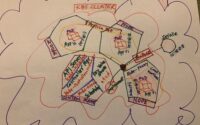Azure in a Nutshell
Azure is Microsoft’s cloud platform, basically built on the good old Virtualization technology surrounding Hypervisor. Hypervisor or Virtual Machine Monitor (VMM) as it is originally called, is a group of software and firmware that helps to emulate the basic computer functions and operating system by providing an abstract layer between the hardware and the operating system. Hypervisor is usually installed on the host machine and it can emulate virtual machines, thus creating guest machines that can operate as individual machines, even offering different operating systems.
On a large scale, meaning in the cloud realm, this basic concept is extended to millions of racks of servers running Hypervisor in each server and a fabric controller and each server connected to the internet hub on the data center. Each Fabric connector is connected to a firmware called Orchestrator which controls and manages requests from users to create and manage their own virtual machines or apps or services. Thus everything starting from the Orchestrators to the Fabric controllers to the Hypervisors to the individual servers all work together in unison to offer the Azure cloud services.
The GUI for Azure cloud is called Azure portal that allows users to manage their cloud account including subscription management, creation, management, and deployment of apps. & services etc. Azure portal is basically a website (sub domain ‘portal’) under the main azure.com domain through which users log in using their MS/GitHub account and access Azure cloud services. You can get a free account using your credit card and get a $200 credit and still access almost all of the services for free. If you want to continue you can or your account will be closed without charging your credit card.
In essence, Azure is the Microsoft marketplace where you can rent out computing, storage, networking, database, OS, analytical services, IoT, mobile, DevOps, and AI over its public datacenters that offers these services on their massive datacenters 24/7 so you can focus your time, money, and effort spent on in-house operational backbone/infrastructure/systems.
Azure Datacenter Organization
Azure cloud infrastructure is organized across the globe as regions located in different geographical regions to cater to various parts of the earth/countries. Each region is basically a huge data center either managed by Microsoft directly via a regional entity (such as the US gov in case of Government cloud) or through Microsoft partners such as 21vianet, Wipro, etc. To ensure fail-safe operations, each region has at least 3 availability zones, which is basically a datacenter clone so that you will get high availability operation if one of the zones fails. To extend the availability even further, Azure offers region pairs that offer fail-safe operation across multiple geographical regions. For eg: you may deploy your app./services on the US West region datacenter and US East region datacenter.
Azure Subscription Manager
Azure subscription manager is the service that allows you to manage the creation, allocation, usage, administration, and deletion of Azure resources. You could have multiple Azure resources such as VMs, DBs, Web apps. etc. Resource manager allows you to group these resources into various resource groups based on the type, billing, usage, access, region, etc. The resource manager also allows to tag certain resources with unique tags for easy identification and management. All requests for the resources coming from Azure portal, APIs, SDKs, etc are all routed through the resource manager so there is centralized control and management.
Given the convenience factor, ease of procurement, setup, and use, scalability cloud platforms such as Azure can be a boon to startups who do not have to think about the pain of setting up and maintaining costly infrastructure and other middleware platforms. Given the competition in the cloud space, Microsoft has done a good job in establishing its learning framework that offers a wide variety of hands-on documentation and exercises to get the practitioners up to speed in using this ever-growing platform.
